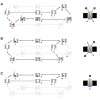
Structure and function of the mammalian sodium/proton exchanger NHE9
NHE9 is a sodium/proton exchanger in mammals, part of a large family of secondary active transporters. Our collaborators (David Drew at the University of Stockholm) solved the structure of NHE9 (SLC9A9) from horse with cryo electron-microscopy to 3.2 Å resolution in an inward facing conformation, the first structure of a mammalian sodium/proton antiporter. Functional measurements, structural bioinformatics, and MD simulations all indicate that many components of the transport mechanism are similar between prokaryotic and mammalian sodium/proton antiporters.



